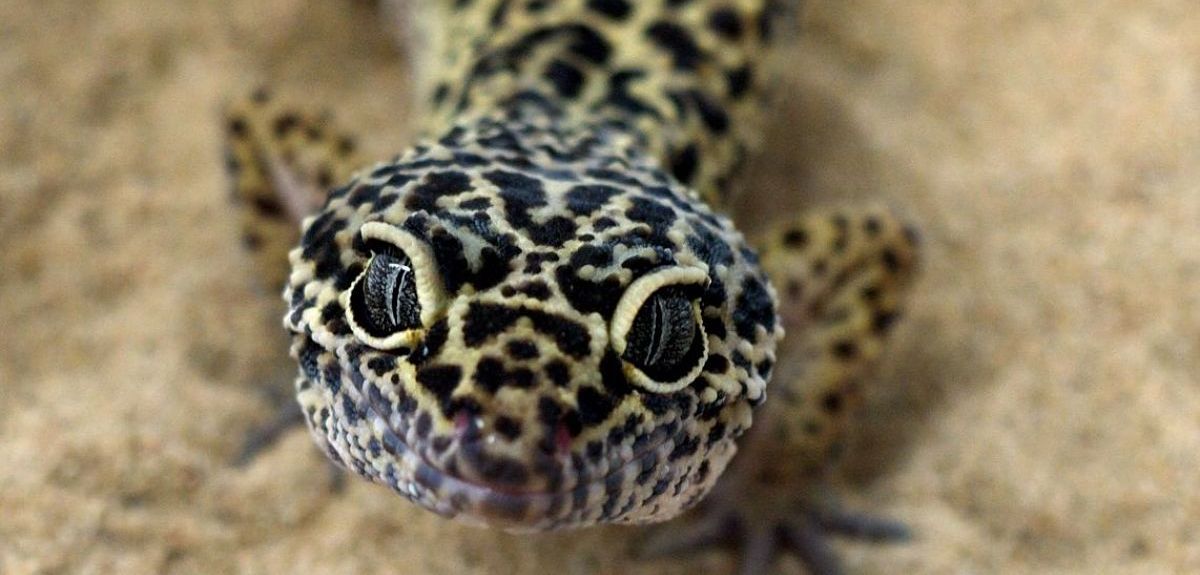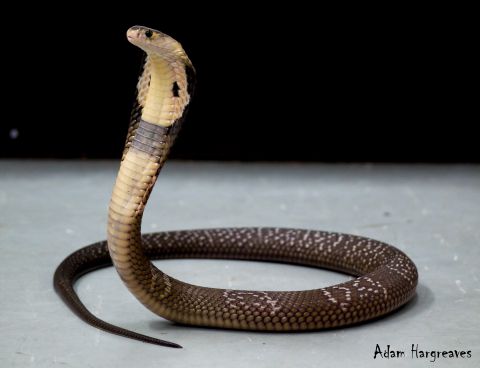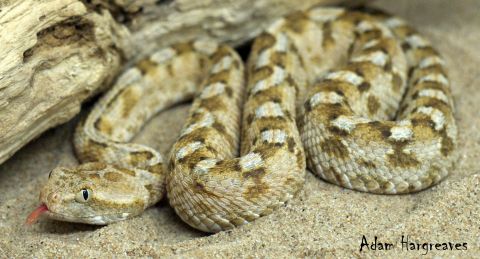
Credit: Dr Adam Hargreaves
An amicable venomous debate
Biologist Doctor Adam Hargreaves studies genetic alterations, how they give rise to novel phenotypes, and how these relate to evolutionary adaptation. His initial studies were of venomous reptiles, which led him to debunk a commonly accepted hypothesis. At a recent debate in Oxford members of the public and members of the International Society of Toxinology sided with Adam’s views on the evolution of reptile venom. Here, he explains the competing stories about how snakes and lizards got their toxins.
How biological novelties evolve, especially when thought to have played a major role in the subsequent success of a group, are of great interest to biologists. Of course, ideas of how these novelties might arise begin as a hypothesis, which can change quite dynamically over time. This has certainly been the case with reptile venom evolution.
Historically, venom was thought to have evolved twice within reptiles; once in venomous snakes (such as cobras) and again in venomous lizards (such as the Gila monster). However, in 2006 a publication in the journal Nature proposed that venom evolved only a single time in reptiles, based predominantly on the shared expression of genes known to encode venom toxins in venomous snakes in the oral glands of snakes and lizards traditionally considered to be non-venomous. It was therefore concluded that the majority of reptiles descended from a common venomous ancestor and, as a result, a new clade was named the Toxicofera (comprising all snakes and a number of lizards), implying the presence of venom in these groups. Consequently, many lizard species previously considered to be non-venomous were designated as venomous, including the Komodo dragon.

Over the past 10 years or so this hypothesis of a single origin of venom in reptiles (the 'Toxicofera hypothesis') has become considered to be established fact, and has been cited in both scientific and popular media (including on several UK television shows, such as QI). However, a large-scale and long overdue test of this hypothesis conducted during my PhD working with colleagues at Bangor University, the Wellcome Trust Sanger Institute and the Institute of Biological, Environmental and Rural Sciences at Aberystwyth University used cutting-edge DNA sequencing technologies to show that this hypothesis was unsupported. Furthermore, a comprehensive review of the evidence previously used to support the Toxicofera hypothesis suggested that it may never have actually been supported.
The study (published in the journal Toxicon) found that genes which had previously been proposed to encode venom toxins were in fact expressed in different body tissues at low levels. There was no evidence for a venom/oral gland-specific splice variant (an alternative product of the same gene which encodes a different protein) or a consistently increased expression of a toxin gene in the oral glands (where toxicity might be dependent on the increased dosage of a particular toxin). With this in mind, it appears that many genes which have been used to support the Toxicofera hypothesis are more likely be 'housekeeping' or maintenance genes, which encode normal non-toxic physiological proteins.
What is it doing expressing these toxin genes in its oral glands? Unless of course, the genes don't actually encode toxins.
In short, many of these genes code for proteins which are not toxins at all, but fulfil other biological roles. Additionally, one species sampled turned out to be crucial. I think one of our key results was that many of the proposed toxin genes are expressed in the oral glands and other body tissues of the Leopard gecko. This species belongs to one of the most basal (oldest) groups of squamate reptiles which pre-date the proposed venomous ancestor. With that in mind, what is it doing expressing these toxin genes in its oral glands? Unless of course, the genes don't actually encode toxins.
These findings have real-world applications for the development of improved treatments for snake bite, as Doctor John Mulley at Bangor University, senior author of the study, explained: 'Ruling out so many of the proposed toxins as actual components of venom means that snake venom is far simpler than was previously suggested, with the majority of venom complexity limited to just a few gene families. It seems likely therefore that we can develop more effective antivenom treatments which focus on combating the effects of just these families. More fundamentally, this new research demonstrates the power of advanced DNA sequencing technologies to shed new light on old questions, and to overturn established hypotheses regarding the evolution of venom in reptiles.'

A survey of gene expression in different tissues of the Burmese python, conducted by a different group of researchers based in the USA, also found that many proposed toxin genes are expressed in many different tissues outside of the oral glands, and at low levels. It appears that evidence to support the multiple evolutions of venom in reptiles is building, especially with the constant improvement and increasing use of DNA sequencing technologies.
As part of the International Society on Toxinology 18th world congress held in Oxford from the 25th to the 30th of September, a public engagement with science session was held for members of the public in the Sheldonian theatre. An Oxford-style public debate was held as part of this session with the motion This house believes that venom originated only once in the course of reptilian evolution. The motion was rejected by an almost unanimous vote, demonstrating widespread support from a large gathering of toxinologists that venom evolved multiple times in reptile evolution.
The differences between venom systems in lizards and snakes is very apparent, most notably how they use their venoms, with venom in snakes being used primarily as a way of immobilising prey items whereas venom in lizards is used as a defensive strategy.
This multiple origins hypothesis is of course the less parsimonious explanation, that is to say a trait evolving once is a simpler process than evolving several times. However, convergent evolution (where non-related species evolve the same trait independently) is widespread in nature, giving rise to analogous structures such as wings in bats and birds; both enable flight, but the evolutionary origins in these animals are different. The same can be said about the venoms and venom systems in venomous snakes and venomous lizards. Indeed, the differences between venom systems in lizards and snakes is very apparent, most notably how they use their venoms, with venom in snakes being used primarily as a way of immobilising prey items whereas venom in lizards is used as a defensive strategy.
The research was supported by the Royal Society, the Wellcome Trust and the Biosciences, Environment and Agriculture Alliance between Bangor and Aberystwyth universities, with analyses carried out using High Performance Computing (HPC) Wales infrastructure. The most recent critique of the Toxicofera hypothesis is available as a book chapter.